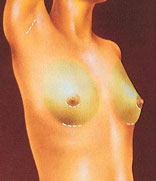

Breast augmentation is usually done to balance a difference in breast size, to improve body contour, or as a reconstructive technique following surgery.

Incisions are made to keep scars as inconspicuous as possible, in the breast crease, around the nipple, or in the armpit. Breast tissue and skin is lifted to create a pocket for each implant.

The breast implant may be inserted directly under the breast tissue or beneath the chest wall muscle.

After surgery, breasts appear fuller and more natural in tone and contour. Scars will fade with time.
If You’re Considering Breast Augmentation…
Breast augmentation, technically known as augmentation mammoplasty, is a surgical procedure to enhance the size and shape of a woman’s breast for a number of reasons:
To enhance the body contour of a woman who, for personal reasons, feels her breast size is too small.
To restore breast volume lost due to weight loss or following pregnancy.
To achieve better symmetry when breasts are moderately disproportionate in size and shape.
To improve the shape of breasts that are sagging or have lost firmness, often used with a breast lift procedure.
To provide the foundation of a breast contour when a breast has been removed or disfigured by surgery to treat breast cancer.
To improve breast appearance or create the appearance of a breast that is missing or disfigured due to trauma, heredity, or congenital abnormalities.
By inserting an implant behind each breast, surgeons are able to increase a woman’s breast size by one or more cup sizes. If you’re considering breast augmentation, this will give you a basic understanding of the procedure–when it can help, how it’s performed, and what results you can expect.
Planning Your Surgery
In your initial consultation, Dr. Ameer will discuss your expectations, evaluate your health and explain which surgical techniques are most appropriate for you. Much depends on your individual circumstances. Based on the condition of your breasts Dr. Ameer may also recommend a breast lift. Breast augmentation can enhance your appearance and your self-confidence, but it won’t necessarily change your looks to match your ideal. Before you decide to have surgery, think carefully about what you want to achieve and discuss them during your consultation.
The best candidates for breast augmentation are women who are looking for improvement, not perfection, in the way they look. If you’re physically healthy and realistic in your expectations, you may be a good candidate.
Breast augmentation is relatively straightforward. But as with any operation, there are risks associated with surgery and specific complications associated with this procedure.
While the majority of women do not experience these complications, you should discuss each of them with your physician to make sure you understand the risks and consequences of breast augmentation. Capsular contracture, infection, changes in sensitivity, and numbness can occur. Occasionally, breast implants may break or leak. Rupture can occur as a result of injury or even from the normal compression and movement of your breast and implant, causing the man-made shell to leak.
Types of Implants
The choice of implant (silicone or saline), implant size, shape and other features will be determined based on your breast anatomy, body type and your desired increase in size. Your lifestyle, goals and personal preferences, as well your plastic surgeon’s recommendations are all determining factors.
Breast implants are medical devices with a solid silicone, rubber shell. The implant shell may be filled with either saline solution (sterile salt water) or silicone gel. Both saline and silicone gel breast implants are approved by the U.S. Food and Drug Administration (FDA). Saline implants are FDA approved for augmentation in women 18 years of age and older. Silicone implants are FDA approved for augmentation in women age 22 and older.
The size of a breast implant is measured in cubic centimeters (ccs) based on the volume of the saline or silicone filler. Breast implants vary both by filler and in size, but there are additional features to consider:
Texture: the implant shell may be smooth or textured
Shape: the implant may have a round profile or one that is anatomic (teardrop or tapered shape)
Profile: the implant may have a low, medium or high projection (the depth of the implant from the base to the highest point of the implant curve)
Diameter: the width of the implant measured across it’s base (the side of the implant that will be positioned over the chest wall)
You should be aware that breast implants are not guaranteed to last a lifetime and future surgery may be required to replace one or both implants. Regular examinations for breast health and to evaluate the condition of your implants are important whether you have chosen saline or silicone breast implants.
Down Time
You should be able to return to work within a few days, depending on the level of activity required for your job. Dr. Ameer will give you instructions on when to begin exercises and normal activities.

